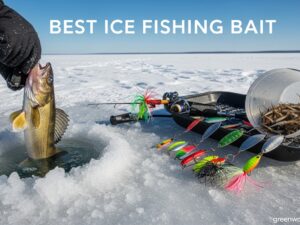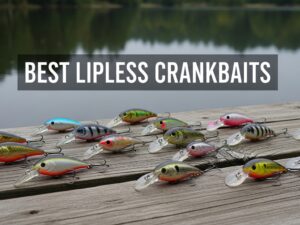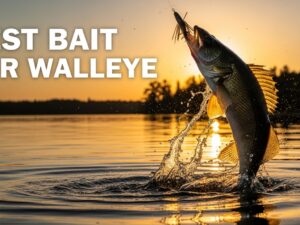Bluefish are the ocean's most aggressive predators, earning nicknames like "choppers" and "yellow-eyed devils" for their ferocious feeding habits. Whether you're targeting these powerful fighters from shore or boat, choosing the right bait can mean the difference between an empty cooler and the catch of a lifetime.
The best bait for bluefish includes oily fish like bunker, mackerel, and eels, paired with essential wire leaders to prevent bite-offs. Fresh cut bait, live baitfish, and proven lures like diamond jigs and poppers also produce excellent results when presented correctly.
Many anglers struggle with bluefish because they underestimate these toothy predators' ability to slice through standard tackle. Others miss opportunities by using the wrong bait at the wrong time, ignoring seasonal patterns that dictate feeding preferences.
This comprehensive guide covers everything from selecting and rigging the perfect live bait to mastering cut bait techniques, choosing the right lures for any situation, and implementing proven strategies for both shore and boat fishing. You'll also learn critical safety tips for handling these sharp-toothed fighters.
Why Is Choosing the Right Bluefish Bait Important?
Bluefish possess razor-sharp teeth capable of slicing through 50-pound monofilament like butter. Their aggressive feeding style and powerful jaws demand careful bait selection to maximize hookups while minimizing lost tackle.
The right bait choice directly impacts your catch rate. While blues often feed voraciously, they can become surprisingly selective during certain conditions, particularly in spring when they're moving inshore or in heavily pressured areas where they've seen countless lures.
Cost-effectiveness varies dramatically between bait options. Premium live eels might cost $5 each, while bunker chunks offer similar effectiveness at a fraction of the price. Understanding these trade-offs helps you fish smarter without breaking the bank.
Shore anglers face different challenges than boat fishermen when selecting best bait for bluefish fishing. Distance casting requirements, current conditions, and limited bait storage all influence which options work best from the beach versus offshore.
Best Live Bait for Bluefish Fishing
Bunker (Menhaden) - The Gold Standard
Bunker reigns supreme as the ultimate bluefish bait due to its oily flesh and natural abundance in blues' feeding areas. These baitfish release irresistible scent trails that trigger aggressive strikes from even the wariest predators.
Rigging live bunker requires a 6/0 to 8/0 circle hook through the nose or back, attached to 12 inches of wire leader. This setup allows natural swimming action while preventing bite-offs that plague anglers using standard monofilament.
Fresh bunker can be purchased at most coastal bait shops or caught using cast nets in harbors and bays. Many shops sell frozen bunker as backup, though fresh always outperforms frozen for finicky fish.
Other Top Live Bait Options
Live eels excel for targeting trophy bluefish, especially during nighttime fishing. Their snake-like swimming motion and durability make them ideal for drifting over structure or fishing techniques similar to flounder fishing.
Herring and sardines work exceptionally well when blues feed on smaller baitfish. These options shine during spring migrations when racers chase tiny bait schools along the beaches.
Live snapper blues and bergalls offer convenient alternatives when traditional baitfish prove scarce. Snapper blues are limited to 10 per angler in most states, making bergalls the sustainable choice for extended trips.
Mackerel and squid round out the live bait arsenal. Atlantic mackerel matches the blues' speed, creating exciting surface strikes, while live squid proves deadly during nighttime feeding periods.
Best Cut Bait Techniques for Blues
Preparing Cut Bait Properly
Successful cut bait fishing starts with proper preparation. Cut bunker or mackerel into triangular chunks roughly 2-3 inches wide, mimicking fleeing baitfish profiles that trigger instinctive strikes.
Score the bait deeply with diagonal cuts to release oils into the water column. This creates an irresistible scent trail that draws blues from surprising distances, especially in murky water conditions.
Fresh bait consistently outperforms frozen options, but properly vacuum-sealed frozen bait works when fresh isn't available. Thaw frozen bait slowly in saltwater to maintain firmness and prevent mushiness that falls off hooks.
Top Cut Bait Choices
Bunker chunks remain the top choice for cut bait, offering the perfect combination of oil content, durability, and availability. Cut them thick enough to stay on hooks during long casts.
Mackerel strips excel when blues feed on sand eels or similar thin-profile baitfish. Cut long, thin strips that flutter enticingly in the current, maximizing their visual appeal.
Squid pieces provide tough, durable bait that withstands aggressive strikes. Their white color stands out in murky water, while their texture keeps them firmly on hooks through multiple casts.
Alternative baits like chicken breast strips (with fat attached) have gained popularity among resourceful anglers. While unconventional, these protein-rich options produce surprising results when traditional baits run short.
What Size Hook for Bluefish?
Selecting the proper hook size ensures solid hookups while minimizing deep hooking that complicates safe release. The following guidelines help match hooks to your target fish size:
| Bluefish Size | Hook Size | Hook Type | Best Application |
|---|---|---|---|
| Snappers (6-10) | 1/0 - 2/0 | Long shank | Light tackle fun |
| Cocktail (12-16) | 3/0 - 4/0 | Circle | Live bait fishing |
| Medium (18-24) | 5/0 - 6/0 | Circle/J-hook | Cut bait/lures |
| Gator (24+) | 7/0 - 9/0 | Heavy circle | Trophy hunting |
Single hooks offer easier unhooking compared to trebles, crucial when dealing with blues' dangerous mouths. Circle hooks reduce gut-hooking, improving survival rates for released fish while maintaining excellent hook-up ratios.
Wire leader remains non-negotiable for bluefish fishing. Use 40-60 pound black wire in 12-18 inch lengths, attached with quality swivels to prevent line twist during fights.
Top 10 Bluefish Lures for Every Situation
Surface Lures
The Roberts Ranger stands as the classic bluefish surface plug, combining extreme durability with irresistible action. Its hard plastic construction withstands countless attacks while the heavy single hook ensures quick releases.
Cotton Cordell Pencil Poppers create explosive surface strikes with their walking action and loud rattles. The 7-inch red/white model produces more bluefish than any other color combination in clear water conditions.
Tsunami Talkin' Poppers offer versatility for anglers targeting top 10 bluefish lures. Work them slow for a traditional popping action or fast for a swimming presentation that matches different feeding moods.
Metal Lures and Jigs
Diamond jigs reign supreme for deep-water bluefish or when matching sand eel hatches. The A-47 size in chrome or green creates an irresistible flutter when jigged vertically or cast and retrieved quickly.
Kastmaster spoons cast incredible distances, crucial for best bluefish lures surf fishing. Their aerodynamic design reaches feeding schools beyond typical casting range while their solid brass construction resists tooth damage.
Deadly Dick lures combine distance casting with unique swimming action. The slim profile closely matches various baitfish that bottom feeders also prey upon, triggering strikes from blues feeding deep.
Soft Plastics
Z-Man's MagSwimZ revolutionized soft plastic fishing for toothy predators. Their ElaZtech construction withstands bluefish attacks that would destroy traditional plastics in seconds, making them cost-effective despite higher initial prices.
Rigging soft plastics on heavy jigheads or weighted hooks allows varying retrieve depths. The 8-inch paddletails create tremendous vibration that calls blues from distance, especially in murky water.
Trolling Lures
The hoochie combines simplicity with deadly effectiveness for trolling applications. Its vinyl squid skirt and weighted head reach productive depths while the wire-rigged hook prevents bite-offs during high-speed strikes.
Tube-and-worm rigs produce when blues feed selectively. Fresh sea worms add natural scent to the pulsating tube action, creating an irresistible combination for finicky fish.
Rapala Magnum diving plugs reach blues holding in deeper water. The NOAA Fisheries reports blues often suspend at specific depths following baitfish schools, making adjustable diving plugs essential tools.
Best Time to Catch Bluefish
Understanding seasonal migration patterns dramatically improves success rates. Spring brings hungry "racers" north from wintering grounds, creating excellent opportunities from April through June as schools move progressively northward.
Summer finds blues spread throughout their range, from Maine to North Carolina. Water temperatures between 64-72°F produce the most consistent action, with fish actively feeding throughout daylight hours.
Fall migration creates the year's best trophy opportunities. September through November sees large blues gorging on bait before heading south, with some specimens exceeding 15 pounds during this feeding frenzy.
Daily feeding windows vary by season and location. While dawn and dusk traditionally produce best, overcast days often see all-day feeding. The first two hours of falling tides consistently produce as bait gets swept from shallow areas.
Seasonal Bluefish Activity Calendar:
- April-May: Northward migration begins, smaller fish arrive first
- June-July: Peak abundance, all sizes available
- August-September: Large fish dominate, best trophy opportunity
- October-November: Fall blitz period, aggressive feeding
- December-March: Southern waters only, sporadic activity
Fishing for Bluefish from Shore
Best Bluefish Lures Surf Fishing
Long-casting metals dominate surf fishing arsenals for good reason. Hopkins spoons, Kastmasters, and diamond jigs reach distant schools while withstanding countless strikes from toothy blues cruising the beach.
Surface poppers excel when blues push bait against the beach. Large pencil poppers and swimmers create commotion visible from hundreds of yards, drawing aggressive strikes in the wash.
Bait rigs demand special consideration for distance and durability. Fish-finder rigs with pyramid sinkers keep bait in the strike zone while allowing blues to run with minimal resistance.
Shore Fishing Techniques
Reading water identifies productive zones before making a cast. Look for diving birds, nervous bait, or surface disturbances indicating feeding activity just beyond the breakers.
Spotting feeding schools requires patience and observation. Blues often reveal themselves through splashes, oil slicks, or birds hovering over specific areas. Move quickly when you spot activity - schools rarely stay in one spot long.
Optimal casting positions balance distance with fish movement patterns. Points, jetties, and inlets concentrate bait during tide changes, creating ambush points where blues predictably feed.
Best Way to Catch Bluefish from a Boat
Trolling strategies vary based on target depth and conditions. Speeds between 5-6 knots trigger strikes when trolling specifically for blues, while 2-3 knots works when mixing with striped bass pursuits.
Chumming with ground bunker creates feeding frenzies that make for memorable fishing. Establish a consistent slick, then drift baits back naturally for maximum effectiveness. The Maryland Department of Natural Resources emphasizes proper chumming techniques for sustainable fishing.
Live bait drifting excels over structure or along current edges. Use minimal weight to maintain natural presentation while covering water where blues ambush prey.
Finding schools with modern electronics streamlines the hunt. Look for bait balls with predators below, or distinctive marks indicating blues suspended at specific depths following food sources.
Pro Tips for Bluefish Success
Wire leader selection makes or breaks bluefish fishing. Choose black coated wire over bright alternatives - blues seem less leader-shy with darker materials that blend into the water column.
Handling techniques prevent painful encounters with sharp teeth requiring similar caution to handling crabs. Use long-nose pliers exclusively, keeping hands well clear of the business end during unhooking.
Bait enhancement tricks multiply effectiveness. Add strips of cloth soaked in bunker oil to lures, or inject dead baits with menhaden oil for extra attraction.
Reading bird activity provides nature's fish finder. Terns diving repeatedly indicate smaller bait and blues, while gannets plunging from height suggest larger predators below.
Safety First - Handling Blues:
- Always use 12+ pliers for unhooking
- Support fish horizontally to prevent thrashing
- Cut hooks rather than risking fingers
- Wear gloves when handling for photos
- Keep first aid kit readily accessible
Common Bluefish Bait Mistakes to Avoid
Using mono leaders instead of wire tops the mistake list. Even 80-pound monofilament falls victim to blues' teeth, resulting in lost fish and tackle. Invest in quality wire leaders.
Wrong hook sizes plague many anglers. Undersized hooks result in poor hookups, while oversized options inhibit bait action. Match hooks precisely to target fish size.
Poor bait presentation sabotages even premium offerings. Bunker chunks spinning unnaturally or live baits restricted by heavy weights fail to trigger strikes from educated fish.
Ignoring seasonal patterns leads to empty trips. Spring blues want smaller offerings matching tiny bait, while fall fish prefer larger meals. Adjust tactics accordingly throughout the season.
Frequently Asked Questions
Can You Use Artificial Bait for Bluefish?
Absolutely! Best bluefish fishing lures often outperform natural bait, especially when blues feed aggressively. Metal lures, poppers, and soft plastics all produce excellent results when matched to feeding conditions.
What's the Best Bluefish Bait for Beginners?
Fresh bunker chunks on a simple fish-finder rig offer beginners the highest success rate. This setup requires minimal skill while producing consistent results from both shore and boat.
Do Bluefish Prefer Live or Cut Bait?
Preference varies by conditions and season. Live bait excels when blues feed selectively, while cut bait works better for covering water and attracting fish from distance with scent trails.
How Do You Keep Bait Fresh for Bluefish Fishing?
Store bait on ice but never in direct contact, which causes freezer burn. Use quality coolers with drain plugs, layering ice and newspaper to maintain optimal temperature without waterlogging.
What Unusual Baits Work for Bluefish?
Adventurous anglers report success with chicken strips, turkey necks, and even hot dogs. While these alternatives work in a pinch, traditional marine baits consistently outperform novelty options.
Conclusion
Success in bluefish fishing starts with selecting the right bait for your specific situation. Whether choosing oily live baits like bunker and eels or reliable lures like diamond jigs and poppers, matching your presentation to the blues' mood makes all the difference.
Remember that wire leaders remain absolutely essential regardless of your bait choice. These toothy predators will humble any angler who forgets this critical component, turning sure catches into frustrating bite-offs.
Seasonal patterns strongly influence bait preferences, so adjust your approach as blues transition from spring racers chasing tiny bait to fall gorgers attacking anything that moves. Stay flexible and observant for best results.
Now that you're armed with comprehensive bait knowledge, it's time to hit the water. Share your bluefish bait success stories and unconventional tactics that have worked for you - the fishing community thrives on exchanged knowledge!



